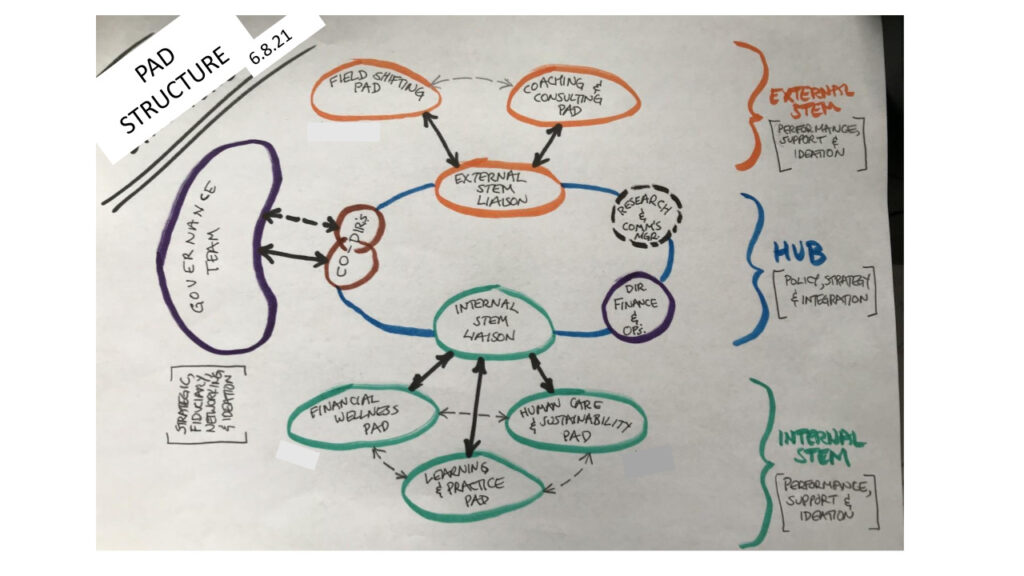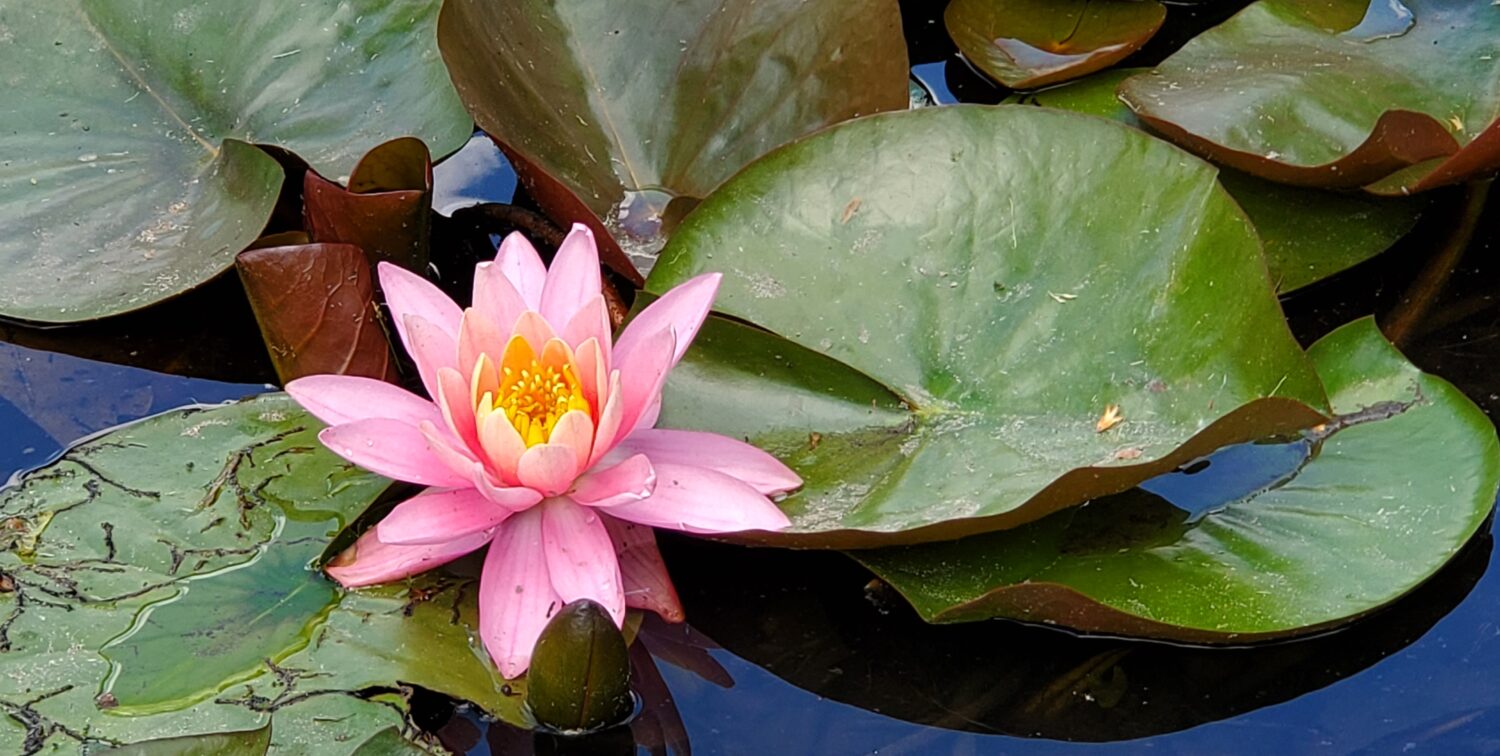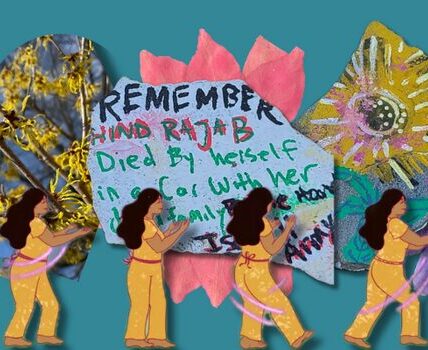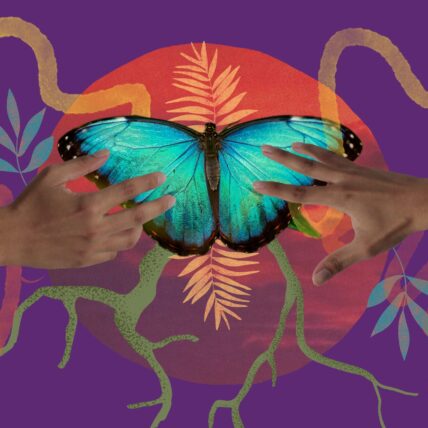Members of our initial Leadership Hub contributed to the learning and crafting of this piece: Delia Allen O’Brien, Natalie Bamdad, Aja Couchois Duncan, Alison Lin, Mark Leach, Elissa Sloan-Perry, and Natasha Winegar. The writing was done by Aja Couchois Duncan, Mark Leach, Elissa Sloan Perry, and Natasha Winegar. We’d also like to thank Governance Team members Rajiv Khanna, Zulayka Santiago, and Marissa Tirona for their thought partnership and generative ideas about “what do we mean when we say evolution?”
“Snowflakes, leaves, humans, plants, raindrops, stars, molecules, microscopic entities all come in communities. The singular cannot in reality exist.”
Paula Gunn Allen
The story of evolutionary biology is one of multiplicity and interdependence, an ongoing balancing and rebalancing, as nothing and no one ever fully stills. Through this process, beings develop amazing capacities for resilience, adaptation, and generativity such as specialization, coordination, awareness, and the ability to feel. This evolution requires (re)learning the ways of being and doing that have existed for millennia, to carry forward the wisdom and experience of those that came before us, while letting go of that which doesn’t support us to thrive.
Shared leadership is also a story of our multiplicity and interdependence. Once we begin peeling away the layers of white supremacy—the layers of assumptive hierarchy, of privileged information, and unnecessary secrecy—we look around and find ourselves; people divergent in need and experience who have come together in a shared purpose. We wonder what remembered/recovered or never lost —and new—ways of being and doing will best support us. What now, we ask each other. Indeed, what now?
As two of our Governance Team members recently shared:
“This is not to go to something entirely new. It is about going to ways of being that already existed, predating white supremacy culture and systems of oppression.”
Marissa Tirona
“Evolution is about holding the paradox of looking boldly towards the future, being firmly rooted in the present, while always paying homage to the past.”
Zulayka Santiago
At the close of 2020, we wrote about our journey deeper into shared leadership and how we navigated some of the rugged terrain along the way in Moving Toward a Culture of Shared Power that Prefigures a Liberated World. In this new reflection, we share what has happened since, particularly exploring the embodied experiences of being on this shared leadership journey, the emotional undertows, and oppressive and liberatory currents.
Chrysalis and Our Early Rhythm
We called our first formation of shared leadership Chrysalis. It was a temporary holding and a space to grow into something different—a way of being and of doing the work that would be new for us—where five people were holding organization-wide leadership. As we lived more deeply into the Chrysalis phase, we were able to co-lead more seamlessly. It took some stumbling as we began to understand what we could clarify in advance and what needed to emerge organically so we could feel our way toward what would work best for the five of us. It took our shared enthusiasm for the experiment, our willingness to be authentic, call challenging questions, and give one another some space and grace. We got increasingly clear about who needed to be in which conversations and what leadership was shared more broadly versus what leadership was still held by our two codirectors. We got into a rhythm.
But we hadn’t transformed one of our organizational tensions, which was a structure and practice of relying on two individuals to hold the highest level of organizational responsibility and decision-making. And this meant that while the codirectors felt a sense of gratitude for some of the weight lifted from their shoulders, we hadn’t achieved greater balance and multiplicity in our levels of responsibility for decision-making and accountability.
We hadn’t expected to achieve this during our Chrysalis phase; we were evolving so that a new shape could emerge with a greater number of people are weaving vision, discerning strategy, and making decisions with accountability for the hard choices such that we are living into the interdependence and shared power of our imagined future.
Butterflies, Pads, and a Hub
After about six months—a bit longer than a monarch’s two-week chrysalis phase (but then humans and their organizations are larger and slower than most butterflies)—our new shape emerged. It was affectionately called the Pad Structure (as in lily pads), and then Pads & the Hub.
This new shape created work teams or “Pads”: three internally focused ones (Financial Wellness/Sustainability, Human Care & Sustainability, and Learning & Practice) and two externally focused ones (Field Shifting and Coaching & Consulting).
Pads have 2 main purposes:
- Ideate – to assess what’s happening in the organization, field, partnerships, etc. and discern what might be needed by coming up with ideas and recommendations about possible ways forward. If something that comes up concerns high-level organization-wide policy or strategy, Pads make a recommendation to the Hub. If an issue is more tactical, the Pad can make a decision.
- Implement – To carry out the practical aspects of a policy or strategy decisions related to their area of work.
Everyone in the organization participated—and still does—on one or more pads. This structure and practice of distributed leadership made for a much greater connection within the organization. Previously some team members mostly connected during twice-monthly all-staff meetings and now were engaged in organization-wide conversations with others with an eye toward strengthening our overall sustainability and impact.
This new shape also created an expanded leadership team of six people we call the Hub, accountable for organization-wide policy and strategy decisions, and for integrating work and priorities across Change Elemental. Two Hub members acted as “stem liaisons,” whose responsibility was and is to connect the ideas, learning, and recommendations from the pads into the Hub. The two codirectors remained in the Hub, but no longer were the only ones accountable for organization-wide decision-making, creating capacity to better support the growth of the group and advancement of our shared leadership and our vision.

The Hub’s Rhythm is Stitched and Back Stitched
In basket weaving, when you run out of needles, you can add new ones in without additional stitches. But when you run out of raffia, what you are sewing with, additional steps and stitches are needed. When we launched the Hub formation, expanding the team and including new leaders meant stitching back to stitch forward, strengthening our leadership container. While the Hub’s growth from five to six doesn’t sound like much numerically, it was significant, especially since two of the team members were new to the leadership group. Mark Leach, current Senior Consultant, former Interim CoDirector (in Chrysalis and the Hub), recently reflected that:
“We add people to shared leadership arithmetically, but the relationships to be developed geometrically.”
In the earlier Chrysalis phase, the five-person leadership group began to meet for 30 mins each day to address immediate questions and move work forward. There were usually three or four of us present—whoever could join that day. We also had longer “Holding the Whole” conversations every other week for 90 minutes. These were the times we addressed bigger questions, ones that required pre-planning, data gathering, and more extensive time to come to a shared resolution.
In the Hub formation, personal check-ins took half of our 30-minute meetings. The longer Holding the Whole conversations needed a lot more context-setting as two new people on the leadership team meant there was less shared understanding. Also, more people meant more difference in terms of styles, beliefs, and experiences to learn and bridge.
“Our own [individual] notions of risk-taking, scarcity, abundance, and comfort with the unknown surfaced in our leadership; the roots of which are connected to race, power, and privilege.”
Alison Lin, Senior Consultant and former Chrysalis leader
In the Hub, we got into it. The backstitching, while complex and time-consuming, also created anew and revealed other stitching that was needed in our broader organizational basket. We had frustrating, complex, and transformative conversations about everything from what constitutes a reasonable operating financial cushion to our hiring practices to how race and family economic legacies should drive considerations about equitable compensation. We got better at “speaking truth” to one another, including about individuals’ strengths and areas of growth. In doing so, we deepened our trust and made better choices about who should do what. We were showing up more fully in our own gifts and power—so while we were putting in more hours, that work was coming as a joyful expression of what one is good at and passionate about. And when it wasn’t feeling joyful, we had greater skill and trust with each other to name and hold it.
People also increased their capacity to hold Change Elemental’s vision and strategies more fully and deeply and to do so in relationship to their personal purpose as individuals. With these stitches stronger, the leadership container/basket started to hold wherever Hub members were showing up – it was able to hold more, last longer, and travel further toward being the future we want to see.
While generative and joyful, it was and is also exhausting for some staff. And with the Pads & Hub structure, there were and are a lot of meetings. So many meetings! We have each hit a wall occasionally on what more we can take on or handle. We’re getting better at having conversations that are more generative than redundant, making decisions more nimbly, and having the right number of weavers stitching into the same spot in the basket at a time. For a while, some staff felt (and some still feel) the balance has shifted away from what we were wanting to create in the world to an overwhelming focus on our internal relationships and structures. And too these things are one and the same. How we be with each other (tend to ourselves, each other, and our relationships) has profound implications for how we be with our clients and partners, as well as what we can do (shifting structures, systems, policies, programs, etc.) internally and externally.
“Interdependence requires a degree of wholeness of people and of teams, otherwise all we are capable of is codependence that is responsive to immediate needs rather than to purpose.”
Elissa Sloan Perry (current Leadership Hub member)
Nourishing this interdependence requires nourishing our relationships, building trust, and creating the spaciousness for the individual and collective inner work. This is emotional work and it is messy and made really hard through nonstop Zoom. AND there are limits to our time and attention! We were not seeking to create the conditions by which the work was becoming unsustainable. And there were moments when we got close (especially given the external conditions we’ve all been living in for the last few years). In reflecting on the Hub, the team got clear that not every aspect of every relationship had to be maximal in order to be liberatory. Our care and concern for one another, and the work that care seemed to generate, could at times feel oppressive. What we needed to do, what we are learning to do, is to get better at discerning those moments and having the courage to trust our awareness of what is enough and what is too much.
The Hub’s Next Evolution
We are now slimming and shifting the Hub to be a four-person team that currently includes Elissa Sloan Perry, Delia Allen-O’Brien, Natalie Bamdad, and Natasha Winegar. Together, the team will be holding the whole of our vision, values, and strategies as well as human and fiscal sustainability.
Our specific areas of focus include: Delia – fiscal sustainability; Natalie – coaching and consulting work; Natasha – communications and field shifting; and Elissa – vision and tending to our growth in practicing the elements of transformative change. Other folks who were integral to our evolution process and earlier leadership structures will bring their gifts, wisdom, and experience as advisors to the Hub. This includes Mark Leach, who is shifting from Interim CoDirector to Senior Consultant, Aja Couchois Duncan, and Alison Lin. Other colleagues, including Deborah Berry, Pam Sysiuk, Naima Yael Tokunow, Monica Tyran, and Tamitha Walker-McKinnis also brought forward (and are continuing to bring) gifts as pad leads and members, without whom this evolution wouldn’t be possible.
While fewer people are sharing the core leadership and organization-wide decision-making, significant areas of organizational holding also exist elsewhere. The other shifts we have made to our overall shared leadership structure, practices, and ways of working together will support this new formation. Pads members are now sufficiently steeped in the issues and have developed enough trust, knowledge, and skill to hold and move things together more quickly and nimbly. Pads have created a place where ideation and implementation can live without overwhelming the Hub with all the downstream consequences of policy and strategy decisions. These evolutions support the Hub to focus more on its core responsibility: making and being accountable for organization-wide policy and strategy decisions while holding the whole of the organization and our vision.
We have landed the core responsibility of the Hub, and don’t anticipate much change here. We also anticipate that the Hub composition and practices will continue to evolve based on what is needed to advance shared power, shared leadership, and a thriving organization. For now, we are all breathing a sigh of relief as we have gotten through some of the hard parts of evolving our leadership formation, to the point where we’re sharing power in trust and in fuller knowledge of each other’s gifts and growth edges. We can benefit from even more prioritization, streamlining and letting go, and strengthening our capacity for generative conflict, truth-telling, and collective inner work. We can now say from lived experience two other elegant principles: sometimes, “less is more”1 and there’s a “ simplicity on the other side of complexity.”2
1A phrase originating from the poem, “Andrea Del Sarto,” by Robert Browning, popularized by designer Ludwig Mies Van Der Rohe
2 Former Supreme Court Justice, Oliver Wendell Holmes, Sr.





